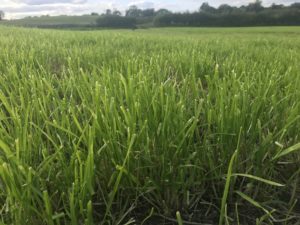The high rainfall throughout the Summer and Autumn of 2023, continued over the winter months, resulting in large acreages of grassland and crops sitting under water throughout the country, with soils being left waterlogged. Cattle were brought in earlier than normal putting high demand on forage stock. Whilst everyone is hoping for a kind spring and an early turnout to relieve some of the work and feeding pressures, grazing and silage fields may need some attention to manage them back to their full potential. While the condition of some fields may look disastrous, they may not be as bad as they seem, and many could be turned around into being highly productive.
Start by assessing each field, the Barenbrug Grass Management guide indexing system gives a straightforward practical approach on how to do this. Based on a 1 – 5 index with an INDEX 1 field being the worst, it will have less than 25% sown species remaining and unlikely to be very productive and in need of a complete reseed. An INDEX 5 field being in the best shape it will have over 80% sown species with clover making up 30-40% of the plant population if sown. There will be minimal weed content or gaps requiring practical management techniques to get the most from an index 5 ley.
Just because a field looks green doesn’t mean it will have productive grasses present. Weed grasses typically yield between 7-9 t DM/Ha, they are also inefficient in their use of nitrogen and will only utilise between 17-30% of any nitrogen applied. Making it all the more important to regularly assess fields to improve grass yield, quality and fertiliser use efficiency.
Don’t overlook the soil
The effects of long periods of rain and standing water can be huge on soil structure. 25mm of standing water over one hectare is around 250,000 litres of water and equates to 250-tonnes in weight sitting on the field! The compaction this causes reduces grass growth, inhibits rooting and the plants ability to absorb nutrients, as well as reducing the soils nutrient cycling. Compacted soils are generally colder and take longer to warm up in spring which in turn reduces grazing days or gives a later start to cutting. Studies have shown how soil compaction reduces grass growth – and yield –by between 10 and 20%. The best way to identify compacted areas is by digging holes, ideally in two parts of a field – a good area as well as the suspect area – to compare the differences. Look closely at the colour, friability, root growth, the presence or absence of worms, and how it smells. This is also the ideal time to address soil fertility issues. If you haven’t taken a recent soil sample take one now to identify fields of low pH (grass crops require pH of 6.5) and any limiting nutrient issues that may affect plant health and grass growth. Speak to your local NWF Sales Specialist about our soil analysis kits.
Address Winter Growth
This winter growth has been generally weak, of poor quality, producing dead material at the base of swards which will be unpalatable to dairy cattle when turned out in spring resulting in poor utilisation and intake. The winter growth really needs removing to reset the growth cycle of the grass sward, so it produces good quality, palatable leafy grass when spring growth kicks in. In an ideal world, the best option would be to graze with sheep, or even youngstock in drying fields that will carry them. Be careful to avoid poaching though.
Keep an eye on soil temperatures in readiness for fertiliser applications. Making sure the grass crop is fed to its requirements. Don’t forget to use sulphur with nitrogen and replace any P & K removed by cutting and grazing.
For further information on NWF grass seed, please click HERE.
By Roger Bacon, Barenbrug Agricultural Key Accounts Manager.

